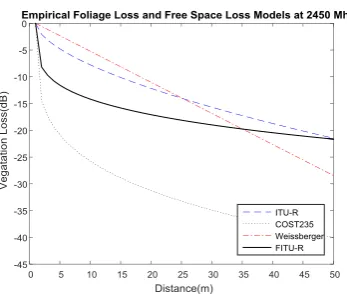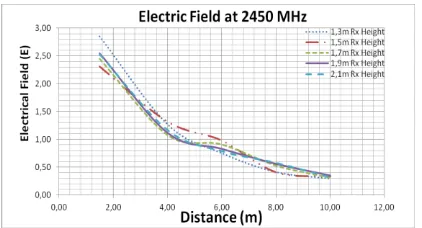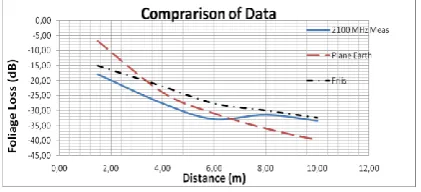w w w . i j m r e t . o r g I S S N : 2 4 5 6 - 5 6 2 8 Page 14
Experiments of the Propagation through Forest at GSM
Frequencies (2G-3G-4G)
Saban Selim Seker
1, Fulya Callialp Kunter
2,3, Osman Çerezci
4, Kaan Karabag
1 1(Electrical and Electronics Engineering Department, Bogazici University, Turkey) 2
(Electrical and Electronics Engineering Department, Marmara University, Turkey) 3
(Electrical Engineering Department, Chulalongkorn University, Thailand (on sabbatical leave)) 4
(Electrical and Electronics Engineering Department, Sakarya University, Turkey)
ABSTRACT : The increasing demand of clear communication in any situation and in any environment leads people to find a better way to communicate. Since the presence of tree canopies can affect the ability of a GSM signals through its way, one of the hardest environment is forested areas. In order to find a better way to communicate, the propagation features of the environment should be known.This study investigates the attenuation characteristics of GSM (2G, 3G and 4G) frequencies in the forest. Some theoretical models from literature were studied and simulated. The electrical field of the transmitted signal was measured in Sakarya. Due to weather and seasonal conditions, experiment was re-modeled with the trees with small, thin trunk and high amount of leaves. Finally, the literature data and experimental data were compared and discussed.
KEYWORDS -attenuation, forest, GSM frequencies
I. INTRODUCTION
The whole forest, a line of trees or a single tree canopy have major effects on the quality of the signal. As a general view, frequency, randomly settled leaves, branches, and the size and shape of trunks may cause attenuation on the received signal. The total fields in the medium are formed by coherent and diffuse parts. The coherent fields are the forward scatters which pass through the leaves or trunks, whereas the diffuse part is known as back scattering. During the propagation, coherent fields dominate at first, but absorption in leaves and trunks decrease its effect[1-7].
Rogers[8] worked on radio propagation through vegetation with generic model of 1-60 GHz. His measurements were conducted at twelve locations in England, including eight species of trees, both in-leaf and out-of-leaf which includes different type of vegetation geometries. Narrowband measurements were analyzed in between 2 and 18 GHz (at 0.5 GHz intervals) and wideband measurements were conducted with 31 MHz bandwidth at 1.3, 2.0, 11.2 GHz and 120MHz bandwidth at 2.2, 2.4, 37.5 and 61.5 GHz. The generic model combines the effects of three individual propagation modes: diffraction from the side and top of the foliage, ground reflection and direct (through vegetation) propagation. The direct (through vegetation) ray is modeled using the theory of radiative energy transfer (RET) which accounts for both scattering and absorption. RET
predicts the attenuation vs. foliage depth using parameters to describe the absorption and scatter cross-sections, albedo, and scatter function (phase function) of the vegetation.In Twyning Nursey measurement with London Plane tree types which has 6m of height, Tx and Rx is placed at 3.5 m above of the ground.
The graph of excess attenuation as a function of foliage depth, shows that excess attenuation due to the presence of foliage increased with frequency. All three frequencies suffered from less excess attenuation in the absence of leaves, indicating that leaves act as an attenuating medium at 1.3GHz, 2GHz and 11.647GHz. It also indicates that the excess attenuation curve exhibits a dual slope characteristic and the initial slope is steeper with an increase in frequency.
w w w . i j m r e t . o r g I S S N : 2 4 5 6 - 5 6 2 8 Page 15 results obtained by the present models are in good
agreement with published results.
The excess vegetation attenuation due to the Date Palm trees has been investigated at 2.1 GHz in North of Abu Dhabi city, UAE under typical semi-desert conditions. The measured data was used to evaluate the performance of the ED and the ITU-R MA models. The ED model gives an RMS error equal to 5.97 dB against the measured data. The ED model’s parameters are modified, and the modified model gives an RMS error equals to 3.66 dB against the measured data. Furthermore the measured data used to obtain the best ITU-R model (MA) parameters values related to semi-desert enlivenment. A comparison between the ITU-R model parameters values yield based on measurement carried in Brazil, France and UAE shows an RMS equal to 10.60 dB for Brazil values, 4.37 dB for France values and 3.59 dB for UAE Data against the measured data.
Seker [10] investigated the forest with radio frequency propagation model. The forest is modeled using discrete method where incoherent waves dominate over coherent waves. Tree trunks, branches, and needles are characterized by randomly oriented, lossy dielectric cylinders. Leaves are characterized by dielectric discs. The scatterer orientation and distribution are prescribed. The biophysical input parameters to the model are gathered from an experimental site. Theoretical attenuation based upon the biophysical parameters of vegetation is compared with measured values for both horizontal and vertical polarization and excellent agreement is obtained.The forest is considered as an unbounded medium of randomly oriented and positioned homogeneous canonical scatterers representative of various vegetative components. For this case, a simple plane-wave solution to the mean-wave equation can be found. This allows direct and explicit calculation of propagation parameters and attenuation rates without introducing the complicated features of sources and boundaries.
They found out that multiple component model allows a sophisticated and realistic representation of forest attenuation. Comparison with data from the Florida campaign, where all the required parameters were carefully measured, show the model performs well with good quality input data. The numerical results show that the intensity
of incoherently scattered fields increases relative to that of the coherent (mean) field with increasing distance from the source and with increasing frequency. Thus incoherent fields within the forest will be the dominant propagation mechanism at S-band and above. The rate of attenuation naturally varies with the density of the woods and the degree of undergrowth. It is greater for trees in full leaf than for bare trees and increases when foliage is wet. Around S-band, there is little difference in the loss rate between horizontally and vertically polarized waves. During experiments, we observed that increasing the antenna height generally reduces the propagation loss. This is particularly true, as expected, when the height of both antennas exceeds the height of the foliage.
Joshi [5] did his near-ground channel measurement over line-of-sight (LOS) and forest path. Near-ground radio-wave propagation is of interest for emerging military applications such as battlefield sensor networks and for wireless communication between dismounted soldiers. Narrowband and wideband channel measurement results at 300 and 1900MHz are presented for near-ground propagation, characterizing the effect of antenna heights, radiation patterns and foliage environments. An additional set of channel measurements was performed to study the effect of rain on near-ground propagation at 1900MHz in a forest environment. Measured power–delay profiles indicate significant multipath propagation with the multipath components becoming stronger relative to the direct path for decreasing antenna heights. In the LOS measurements, the RMS delay decreased with the use of directional antennas and increasing antenna heights, and increased with distance. This effect was not evident in the forest measurements, suggesting a larger angle of the multi paths. Measurement results indicate that leaves and wet foliage do not contribute significantly to the scattering of radio waves. Foliage effects are more significant at 1900MHz than 300MHz. Results from near-ground sensor measurements demonstrate that path loss varies inversely with the square of the receiving antenna height, as in the plane-Earth and Egli models[11].
w w w . i j m r e t . o r g I S S N : 2 4 5 6 - 5 6 2 8 Page 16 wideband radio-wave propagation for networks of
wireless sensors collecting battlefield information. In the LOS measurements the multipath components were observed to become stronger relative to the direct path for decreasing antenna heights and increasing distance. A larger average number of multipath components were observed due to scattering at 1900MHz compared with
300MHz using both directional and
omnidirectional antennas. At both frequencies there were fewer observed multipath components when using directional antennas compared with omnidirectional antennas. Normalized power delay profiles measured in the absence of foliage and in rainy conditions were almost identical to the results from measurements prior to autumn, indicating that leaves and wet foliage do not contribute much to the scattering of radio waves.
In this paper, we performed measurements and experiments on complexity of forest environment at GSM signals. In conclusion, it is oberved that tree species, distribution of leaves, geographical position and many other aspects may change the experimental results.
II. EMPRİCAL MODELS
At VHF and lower frequencies, a vegetative medium can be considered as homogenous slab because wavelengths are large compared with the scattering elements and the effects of the scatterers are averaged or smoothed to approximate a homogenous medium. However, this is not true for the electromagnetic waves in the frequency range of UHF and above. Thus it appears that any agreement obtained between experimental results and predictions of a theory with forest as a homogenous medium at frequencies above 400 MHz could be coincidental [12].
There are many models to characterize foliage loss which is conducted at microwave and millimeter waves. Here are some propagation models;
2.1 Weissberger Model
Weissberger's model is a path loss estimation method which occurs from presence of one or more trees. The model is useful between 230 MHz and 95 GHz with the foliage depth of 400m.
Lw(dB)=1.33 xf0.284d0.588, 14m < d ≤ 400m
0.45 xf0.284d , 0m ≤ d < 14m (5)
where Lw is the vegetation loss in dB, f frequency in GHz and d is the depth of the trees in meter. This model is generally used in microwave transmission. There has to be an obstacle between the Tx and Rx. The model is useful where path is blocked by dense, dry and leafy trees [2,9].
2.2 ITU-R Model
LITU-R (dB)= 0.2xf0.3d0.6 (6)
where f is frequency in MHz. This model is useful for UHFs and d < 400m so that majority of the signal propagates through trees [9].
2.3 COST 235 Model
LCOST(dB)= 26.6 xf
−0.2d0.5 , outofleaf
15.6 xf−0.009d0.26 , inleaf(7)
This model is useful at 9.6GHz to 56.7GHz (millimeter wave frequencies) with d < 200 nm, f is the frequency in MHz. In this model, measurements should be recorded in two seasons which the trees are with and without leaves [9].
2.4 FITU-R Model
LFITU-R (dB) = 0.37 xf
0.18d0.59 , outofleaf
0.39 xf0.39d0.25 , inleaf (8)
This model is appropriate the frequencies at 11.2GHz and 20GHz with d <120m, f is the frequency in MHz.
2.5 Free Space Attenuation Model
From Friis equation we get;
Lf(dB) = Gt(dB)+Gr(dB)+147.56-20log(f.d) (9)
where Gt and Gr are gain of the antennas in dBi, f is Hz and d is in m. This is loss of signal in free space without obstacle.
2.6 Plane Earth Model
Modification of the Friis equation gives the Plane Earth Propagation model;
w w w . i j m r e t . o r g I S S N : 2 4 5 6 - 5 6 2 8 Page 17 Gt are gain of the transmitter and receiver antennas
in dBi with respect to isotropic antenna.
III. NUMERİCAL AND EXPERİMENTAL
STUDİES
3.1 Numerical Simulation of the Models The numerical simulations are done according to models that we mentioned in Section 2. Distance between transmitter and receiver antenna is taken from 0m to 80m for each
GSM(2G, 3G,4G) frequencies. MATLAB
simulation program is used to simulate the models. As it is seen in Fig.1, Fig.2, Fig.3 and Fig.4, propagation loss and free space loss increases with the increasing frequency and distance.
Figure 1 Foliage Loss Models at 900 MHz
Figure 2 Foliage Loss Models at 1800 MHz
Figure 3 Foliage Loss Models at 2100MHz
Figure 4Foliage Loss Models at 2450 MHz
3.2 Experimental Results
The experiment took place in the woodland of the Sakarya. The experimental area has the trees with short and thin trunk and high amount of leaves so that we had multilayer of leaf obstacles. The 5 samples are taken within 10m distance and 5 different Rx height. To avoid ground effect as much as we could, Tx is located at 1.5m height from the ground. The day was sunny and clear, but days before the test were rainy so the leaves, trunks and ground was wet which may affect the results. In addition, the samples were taken at 1800 MHz with 10 W Tx power. The samples further from 10m were not included to analyze since attenuation were not changing anymore and our signal was too low.
w w w . i j m r e t . o r g I S S N : 2 4 5 6 - 5 6 2 8 Page 18
Figure 6 Electrical field at 900 MHz
Figure 7 Attenuation at 900 MHz
Figure 8 Electrical field at 1800 MHz
Figure 9 Attenuation at 1800 MHz
Figure 10 Electrical field at 2100 MHz
Figure 11 Attenuation at 2100 MHz
Figure 12 Electrical field at 2450 MHz
Figure 13 Attenuation at 2450 MHz
IV. DİSCUSSİON AND CONCLUSİON
As it is seen in the Fig.14, the results ofthis work are compared with introduced models and literature data from Al-Basheir [9] . COST-235 Model is the most accurate one among the introduced models. Also the literature data is a bit different since the parameters are totally different. My test area doesn't fit with other models in terms of environment, frequency and distance. Also, external effects are important in the outcome.For comparison with the model, Root Mean Square Error (RMSE) is used
RMSE = Lm−Lp
2 N−1 N
i=1 (11)
w w w . i j m r e t . o r g I S S N : 2 4 5 6 - 5 6 2 8 Page 19 In our results, ITU-R RMSE = 26.2 dB,
COST-235 RMSE = 7.56 dB, Weissberger RMSE = 28.7 dB, and FITU-R RMSE = 19.5 dB. So, it seen here that only the COST-235 Model is within the range. On the other hand, PE RMSE = 7.11 dB and Friss RMSE = 4.23 which fit RMSE range.
Figure 14 Comparison with models and literature
Figure 15 Comparison with models
In the Fig.15,our results were compared with Friis Equation and Plane Earth Model. As it is seen, earth effect dominates the field since our equipment were close to the ground. The ground was soil and it was wet, but some parts of the ground had leaves. Therefore it is hard to make conclusion on PE model. To observe the propagation better, there should be more distance and Tx-Rx heights so that reflection or attenuation on the ground will be observed more clearly. As it is said, the test scenario was changed due to seasonal change and weather conditions. Therefore, there are some jumps in the results since the leaves were too intense in the some parts of trees but not the other parts. Also, leaves and soil were a bit wet due to rain a day before which is an important effect on propagation. The literature outcomes and our work do not match some points due to various reasons like; humidity, leaf distribution, tree types, leaf intensity, terrain effect and so on.
V. Acknowledgements
This work is supported by Boğaziçi University Research Foundation project code:9860.
REFERENCES
[1] J. A. Gay-Fernandez, and I. Cıinas, Peer to peer wireless propagation measurements and path-loss modeling in vegetated environments,IEEE Transactions on Antennas and Propagation, 61(6), 201 3302-3311.
[2] M. O. Al-Nuaimi, A. M. Hammoudeh,Measurements and prediction of attenuation and scatter of microwave signal by trees,IEE Proceedings, Microwaves, Antennas and Propagation, 141(2),1994, 70-76.
[3] Y. S. Meng, and Y.H. Lee, Investigations on foliage effect on modern wireless communications systems: Review, Progress in Electromagnetic Research, 105, 2010, 313-332.
[4] K. Low, UHF measurement of seasonal field-strength variations in forests, IEEE Transactions on Vehicular Technology, 37(3), 1988, 121-124.
[5] G. G. Joshi, C. B. Dietrich, C. R. Anderson, W. G. Newhall, W. A. Davis, J. Isaacs, and G. Barnett, Near-ground channel measurements over line-of-sight and forested paths, IEE Proceedings, Microwaves, Antennas and Propagation,152(6), 2005, 589-596.
[6] S. Seker, EM propagation and backscattering discrete model for medium of sparsely distributed lossy random particles,AEU International Journal in Electronics and Communication, 61, 2007, 377-387.
[7] I. J. Dilworth, and B. L'Ebraly, Propagation effects due to foliage and building scatter at millimetre wavelengths, Proc. 9th IEE Int. Conf. Antennas Propagation, Eindhoven, Netherlands, Apr. 1995, 51-53.
[8] N. C. Rogers, A. Seville, J. Richter, D. Ndzi, N. Savage, R. Caldeirinha, A. Shukla, M. O. Al-Nuaimi, K. H. Craig, E. Vilar, and J. Austin, A generic model of 1-60 GHz radio propagation through vegetation, Technical Report, Radiocommunications Agency, May 2002.
[9] S. Al-Basheir, M. Mohammed, R. Shubair, and S. M. Sharif, Measurements and Analysis for Signal Attenuation through Date Palm Trees at 2.1 GHz Frequency, Sudan Engineering Society Journal, 52(45), January 2006.
[10] S.S. Seker, Multicomponents discrete propagation model of forest, IEE Proceedings on Microwaves, Antennas and Propagation, 142(3), June 1995.
[11] M. L. Meeks, "VHF propagation over hilly, forested terrain," IEEE Transactions on Antennas Propagation, 31(3), 1983, 483-489.


